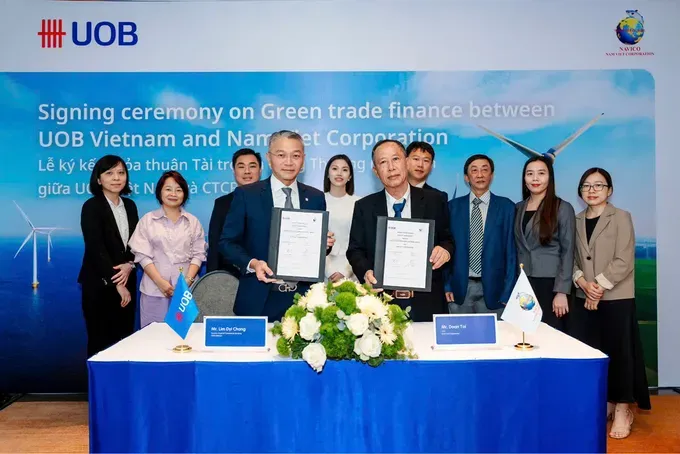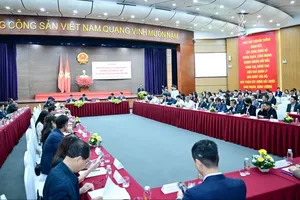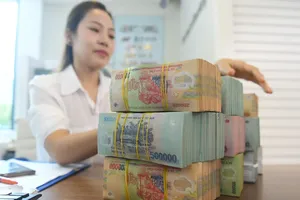
Under Resolution 68 by the Politburo on promoting the private business sector and Resolution 198 by the Government on special policies for this sector, private enterprises, business households, and individuals can now receive a 2-percent annual interest rate subsidy on loans for green, circular projects that adopt Environmental, Social, and Governance (ESG) standards. The policies are seen as a decisive move to break the deadlock in green credit and advance sustainable development.
Since the start of the year, commercial banks have been actively forging partnerships with domestic and international organizations to bolster their green finance capabilities.
HSBC Vietnam, for instance, recently collaborated with Japan’s Mizuho and SMBC banks to announce a VND3.75 trillion (US$148 million) syndicated green loan for Tam Luc Real Estate JSC to develop a green apartment project in HCMC. Nam A Bank also secured a 10-million-dollar disbursement from the Global Climate Partnership Fund to expand its sustainable lending portfolio.
Furthermore, French and Dutch government financial institutions have invested $80 million in SeABank to support small and medium-sized enterprises (SMEs) in adopting international environmental and social risk management standards and fighting against climate change.
Major domestic players are also prioritizing this area. BIDV considers green credit a cornerstone of its long-term strategy, with its outstanding green loan balance reaching VND78.6 trillion ($3.1 billion) by the end of the first quarter in 2025, representing 3.8 percent of its total loan book. BIDV’s General Director Le Ngoc Lam stressed that with sustainable development becoming an inevitable trend, “a complete legal framework and transparent mechanisms to mobilize international green capital are essential for banks to support the economy."
Likewise, UOB Vietnam reported that as of April 2025, it had financed 19 green projects across renewable energy, sustainable manufacturing, and agriculture.
Statistics from the State Bank of Vietnam (SBV) indicates rapid growth in the sector. From a modest VND180 trillion ($7.1 billion) in 2017, the total outstanding green credit balance surged to nearly VND705 trillion ($27.8 billion) by the end of March 2025, with 58 institutions participating.
However, this figure still only represents about 4.5 percent of the economy’s total outstanding loans. A survey by the HCMC Business Association highlights the access issue, revealing that approximately 65 percent of businesses still face difficulties securing capital for green projects.
To better facilitate the rollout of green credit programs, the SBV has collaborated with the International Finance Corporation (IFC) to develop a practical handbook. This guide provides clear instructions on risk identification and assessment, helping banks make informed financing decisions. It serves as a step-by-step manual for credit officers and managers, ensuring that medium and long-term capital is allocated effectively while managing potential risks.
Permanent Deputy Governor Dao Minh Tu of the State Bank of Vietnam
Economic experts believe the 2-percent interest subsidy will remove a significant barrier for private enterprises, especially SMEs and micro-businesses. However, from a banker’s perspective, challenges remain. Lim Dyi Chang, Head of Corporate Banking at UOB Vietnam, noted that many SMEs still perceive ESG compliance as a costly burden.
“Resolutions 168 and 198 are major shifts that encourage the business community towards sustainability, which will reduce costs and enhance competitiveness”, Head Lim Dyi Chang. “However, we are awaiting specific guidance and mechanisms from the authorities to be able to implement them.”
This sentiment was echoed by General Director Tu Tien Phat of ACB. He described the 2-percent subsidy as “very necessary” but warned that past support programs were often hindered by bureaucracy. “Vietnam has had two previous interest support initiatives, but complex procedures and the pressure of post-audits made many banks and businesses hesitant to participate”, he explained. “Therefore, the subsidy alone is not enough. It requires complementary solutions like streamlining administrative procedures, digitizing the credit process, and building a more detailed green credit framework.”
Dr. Nguyen Xuan Thanh, a senior lecturer at the Fulbright School of Public Policy and Management, argued that the primary bottleneck is no longer policy but execution. “The resolutions lay the foundation for reform, but the journey from resolution to action is long and demands decisive, synchronized implementation”, he stated. “To truly support the private sector, we must provide state resources while avoiding the creation of new, cumbersome supervisory bodies, lest we get stuck in the cycle of ‘loosening’ rules only to ‘tighten’ them again.”

)

)




















